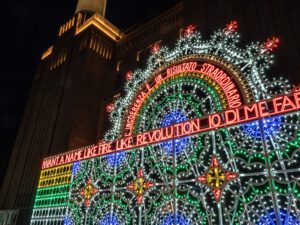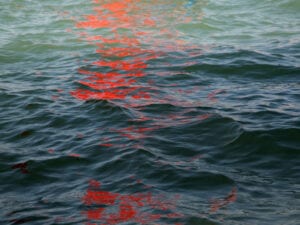The relationship between post-war Italian artists Lucio Fontana (1899 – 1968) and Fausto Melotti (1901 – 1986) is showcased at Mazzoleni, London, this Autumn. FONTANA / MELOTTI: Angelic Spaces and Infinite Geometries explores the practical and intellectual partnership between the artists and their responses to notions of shapes and the spaces in which they inhabit.
Their infamous journey began in 1928 at the Academia di Belle Arti di Brera, Milan, where both artists were students under the direction of Italian Symbolist sculptor Adolfo Wildt (1868 – 1931). Later, the artists’ innovative responses to emptiness and infinity resulted in the transformation of Italian sculpture. Fontana opened both the physical and the imagined space through an array of punctures to the canvas. Through vibration and movement Melotti’s dainty sculptures interacted seamlessly with the surrounding area, creating new spaces. Notions of both conceptual and physical spaces are challenged by, highlighting materiality and the subjects which they choose.
As a prominent Italian artist in the immediate period following the Second World War, Fontana is revered particularly for his “cuts” released on the canvas. End of God (La Fine di Dio, 1963-1964) featured a constellation of slashes that questioned the characteristics of physical forms and the prospect of nothingness. On display are two striking examples of Fontana’s cuts (Concetti Spaziali) in bronze and aluminium, from 1962 and 1965 . These works highlight Fontana’s material affinity with Melotti, in addition to their conceptual connectivity.
Meanwhile, the rhythmic sculptures of Fausto Melotti created from 1950s to the 1980s reflected his continual interest in musical composition. His early education in engineering and music manifested itself as a transformation of musical notation into a visual language of finely wrought structures. The show features rare works from the 1930s – Scultura n.17 (Sculpture no.17) from 1935 – which demonstrates Melotti’s early interest in the sharp and delicate geometry which would define his later oeuvre. This focus on balance and lightness of form is exemplified in works such as I Maggio (1971) with its simplicity of line and Tema e Variazioni IX (1980-1986) which features an intricate yet refined configuration of linear pattern. It is in these works that the dialogue with Fontana’s Concetti Spaziali, such as a three slash white work from 1967, is most evident, revealing both artists’ shared preoccupation with defining space through minimalist constructs.
FONTANA / MELOTTI: Angelic Spaces and Infinite Geometries runs from 28 September – 18 November at Mazzoleni, London. Find out more: www.mazzoleniart.com
Follow us on Twitter and Instagram for the latest in contemporary arts and culture: @AestheticaMag.
Credits:
1. Fausto Melotti, Tre Tempi, 1971, Courtesy Mazzoleni, © Fondazione Fausto Melotti and Hauser & Wirth.





